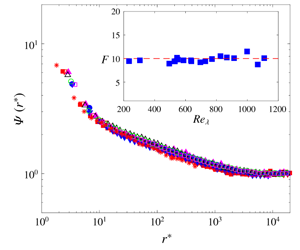Article contents
Scaling of the turbulent energy dissipation correlation function
Published online by Cambridge University Press: 27 March 2020
Abstract

We examine the scaling of the two-point correlation function for  $\unicode[STIX]{x1D716}$, the energy dissipation rate, over a range of values of the separation
$\unicode[STIX]{x1D716}$, the energy dissipation rate, over a range of values of the separation  $r$ between the two points and the Taylor microscale Reynolds number
$r$ between the two points and the Taylor microscale Reynolds number  $Re_{\unicode[STIX]{x1D706}}$. The correlation function is estimated from hot-wire measurements in grid turbulence, along the axes of wakes and jets, and along the centreline of a fully developed channel flow. When
$Re_{\unicode[STIX]{x1D706}}$. The correlation function is estimated from hot-wire measurements in grid turbulence, along the axes of wakes and jets, and along the centreline of a fully developed channel flow. When  $Re_{\unicode[STIX]{x1D706}}$ exceeds a value of approximately 300, a condition which is achieved for both plane and circular jets, the correlation function collapses over nearly all values of
$Re_{\unicode[STIX]{x1D706}}$ exceeds a value of approximately 300, a condition which is achieved for both plane and circular jets, the correlation function collapses over nearly all values of  $r$ when the normalization uses Kolmogorov scales. However, there is no collapse in either the power-law range or dissipative range when the normalization is on the integral (or external) length scale, which indicates that there is no self-similarity based on external scales. Although the maximum value of
$r$ when the normalization uses Kolmogorov scales. However, there is no collapse in either the power-law range or dissipative range when the normalization is on the integral (or external) length scale, which indicates that there is no self-similarity based on external scales. Although the maximum value of  $Re_{\unicode[STIX]{x1D706}}$ is not much larger than
$Re_{\unicode[STIX]{x1D706}}$ is not much larger than  $10^{3}$, the behaviour of the energy dissipation correlation function on the axes of plane and circular jets seems consistent with the first similarity hypothesis of Kolmogorov (Dokl. Akad. Nauk SSSR, vol. 30, 1941, pp. 299–303) but not with the revised phenomenology of Kolmogorov (J. Fluid Mech., vol. 13, 1962, pp. 82–85).
$10^{3}$, the behaviour of the energy dissipation correlation function on the axes of plane and circular jets seems consistent with the first similarity hypothesis of Kolmogorov (Dokl. Akad. Nauk SSSR, vol. 30, 1941, pp. 299–303) but not with the revised phenomenology of Kolmogorov (J. Fluid Mech., vol. 13, 1962, pp. 82–85).
JFM classification
- Type
- JFM Papers
- Information
- Copyright
- © The Author(s), 2020. Published by Cambridge University Press
References
- 12
- Cited by


